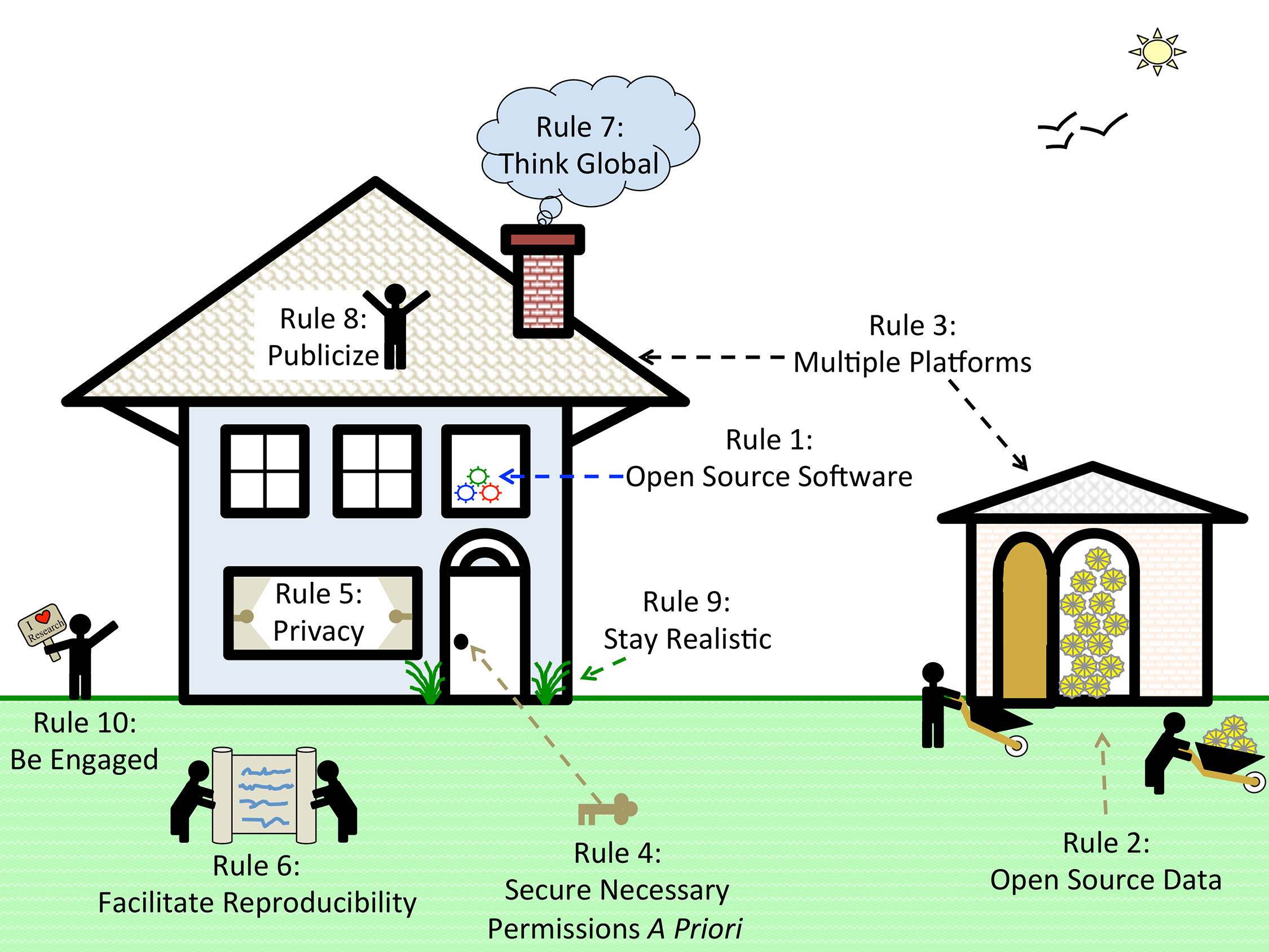File:Fig1 Boland PLOSCompBio2017 13-1.png

Original file (2,250 × 1,688 pixels, file size: 666 KB, MIME type: image/png)
Summary
| Description |
Figure 1. Modern life context for the ten simple rules: This figure provides a framework for understanding how the “Ten Simple Rules to Enable Multi-site Collaborations through Data Sharing” can be translated into easily understood modern life concepts. Rule 1 is Open-Source Software. The openness is signified by a window to a room filled with algorithms that are represented by gears. Rule 2 involves making the source data available whenever possible. Source data can be very useful for researchers. However, data are often housed in institutions and are not publicly accessible. These files are often stored externally; therefore, we depict this as a shed or storehouse of data, which, if possible, should be provided to research collaborators. Rule 3 is to “use multiple platforms to share research products.” This increases the chances that other researchers will find and be able to utilize your research product—this is represented by multiple locations (i.e., shed and house). Rule 4 involves the need to secure all necessary permissions a priori. Many datasets have data use agreements that restrict usage. These restrictions can sometimes prevent researchers from performing certain types of analyses or publishing in certain journals (e.g., journals that require all data to be openly accessible); therefore, we represent this rule as a key that can lock or unlock the door of your research. Rule 5 discusses the privacy issues that surround source data. Researchers need to understand what they can and cannot do (i.e., the privacy rules) with their data. Privacy often requires allowing certain users to have access to sections of data while restricting access to other sections of data. Researchers need to understand what can and cannot be revealed about their data (i.e., when to open and close the curtains). Rule 6 is to facilitate reproducibility whenever possible. Since communication is the forte of reproducibility, we depicted it as two researchers sharing a giant scroll, because data documentation is required and is often substantial. Rule 7 is to “think global.” We conceptualize this as a cloud. This cloud allows the research property (i.e., the house and shed) to be accessed across large distances. Rule 8 is to publicize your work. Think of it as “shouting from the rooftops.” Publicizing is critical for enabling other researchers to access your research product. Rule 9 is to “stay realistic.” It is important for researchers to “stay grounded” and resist the urge to overstate the claims made by their research. Rule 10 is to be engaged, and this is depicted as a person waving an “I heart research” sign. It is vitally important to stay engaged and enthusiastic about one’s research. This enables you to draw others to care about your research. |
|---|---|
| Source |
Boland, M.R.; Karczewski, K.J.; Tatonetti, N.P. (2017). "Ten simple rules to enable multi-site collaborations through data sharing". PLOS Computational Biology 13 (1): e1005278. doi:10.1371/journal.pcbi.1005278. PMC PMC5245793. PMID 28103227. https://www.ncbi.nlm.nih.gov/pmc/articles/PMC5245793. |
| Date |
2017 |
| Author |
Boland, M.R.; Karczewski, K.J.; Tatonetti, N.P. |
| Permission (Reusing this file) |
|
| Other versions |
Licensing
|
|
This work is licensed under the Creative Commons Attribution 4.0 License. |
File history
Click on a date/time to view the file as it appeared at that time.
| Date/Time | Thumbnail | Dimensions | User | Comment | |
|---|---|---|---|---|---|
| current | 20:32, 13 March 2017 |  | 2,250 × 1,688 (666 KB) | Shawndouglas (talk | contribs) |
You cannot overwrite this file.
File usage
The following 2 pages use this file:









